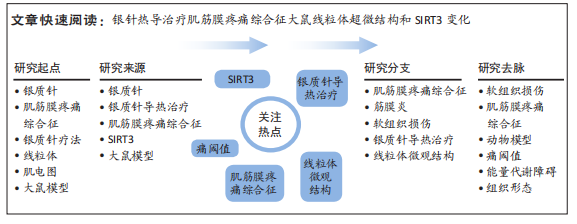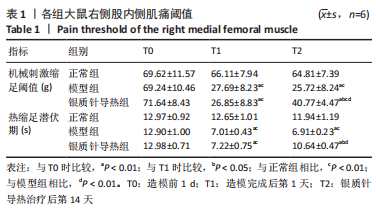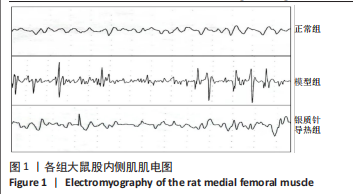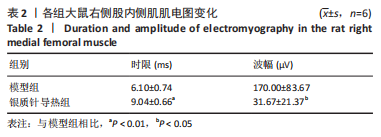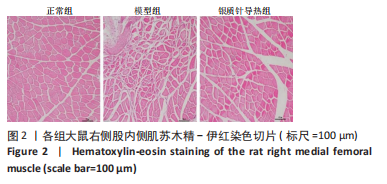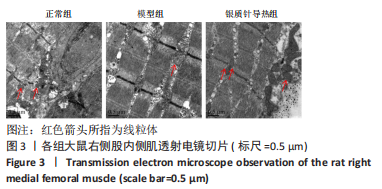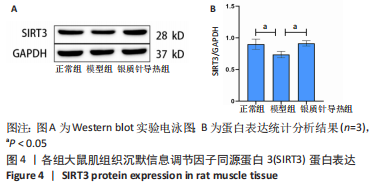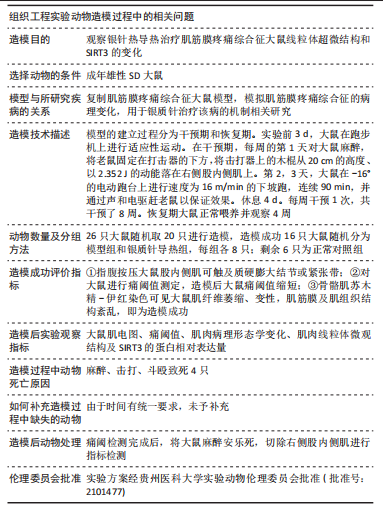[1] FRICTON J. Myofascial Pain: Mechanisms to Management. Oral Maxillofac Surg Clin North Am. 2016;28(3):289-311.
[2] 刘琳, 黄强民, 汤莉. 肌筋膜疼痛触发点[J]. 中国组织工程研究, 2014,18(46):7520-7527.
[3] BRON C, DOMMERHOLT JD. Etiology of myofascial trigger points. Curr Pain Headache Rep. 2012;16(5):439-444.
[4] TRAVELL JG, SIMONS DG. Myofasscial pain and dysfunction: the trigger point manual.Baltimore. MD:U.S.A.wiuiams & Wilkins.1983.
[5] SIMONS DG, TRAVELL JG. Myofascial trigger points, a possible explanation. Pain. 1981;10(1):106-109.
[6] 杨子纯, 杨晓媛, 黄雅倩,等. 银质针疗法临床应用概述[J]. 中医学报,2020,35(9):1904-1907.
[7] 王福根. 银质针导热疗法治疗软组织痛的临床研究[C]. 中华医学会疼痛学分会第七届年会,北京.2007.
[8] 穆强. 银质针导热疗法对肌筋膜疼痛综合征大鼠中枢5-HT、5-HT2A受体表达影响的实验研究[D]. 贵阳:贵州医科大学,2020.
[9] 姚明华, 黄强民.肌筋膜触发点疼痛的实验动物模型研究[J].中国运动医学杂志,2009,28(4):415-418.
[10] 韩蓓, 黄强民, 谭树生,等.大鼠肌筋膜疼痛触发点自发肌电现象和病理组织学研究[J]. 中国运动医学杂志,2011,30(6):532-535,531.
[11] YU S, SU H, LU J, et al. Combined T2 Mapping and Diffusion Tensor Imaging: A Sensitive Tool to Assess Myofascial Trigger Points in a Rat Model. J Pain Res. 2021;14:1721-1731.
[12] FLECKENSTEIN J, ZAPS D, RüGER LJ, et al. Discrepancy between prevalence and perceived effectiveness of treatment methods in myofascial pain syndrome: results of a cross-sectional, nationwide survey. BMC Musculoskelet Disord. 2010;11:32.
[13] AREDO JV, HEYRANA KJ, KARP BI, et al. Relating Chronic Pelvic Pain and Endometriosis to Signs of Sensitization and Myofascial Pain and Dysfunction. Semin Reprod Med. 2017;35(1):88-97.
[14] ZHANG H, Lü JJ, HUANG QM, et al. Histopathological nature of myofascial trigger points at different stages of recovery from injury in a rat model. Acupunct Med. 2017;35(6):445-451.
[15] DUARTE F, WEST D, LINDE LD, et al. Re-Examining Myofascial Pain Syndrome: Toward Biomarker Development and Mechanism-Based Diagnostic Criteria. Curr Rheumatol Rep. 2021;23(8):69.
[16] SHAH JP, THAKER N, HEIMUR J, et al. Myofascial Trigger Points Then and Now: A Historical and Scientific Perspective. PM R. 2015;7(7): 746-761.
[17] BRANDãO ML, ROSELINO JE, PICCINATO CE, et al. Mitochondrial alterations in skeletal muscle submitted to total ischemia. J Surg Res. 2003;110(1):235-240.
[18] YE L, LI M, WANG Z, et al. Depression of Mitochondrial Function in the Rat Skeletal Muscle Model of Myofascial Pain Syndrome Is Through Down-Regulation of the AMPK-PGC-1α-SIRT3 Axis. J Pain Res. 2020;13:1747-1756.
[19] CHIU HC, CHIU CY, YANG RS, et al. Preventing muscle wasting by osteoporosis drug alendronate in vitro and in myopathy models via sirtuin-3 down-regulation. J Cachexia Sarcopenia Muscle. 2018; 9(3):585-602.
[20] WU J, ZENG Z, ZHANG W, et al. Emerging role of SIRT3 in mitochondrial dysfunction and cardiovascular diseases. Free Radic Res. 2019;53(2):139-149.
[21] HIRSCHEY M D, SHIMAZU T, GOETZMAN E, et al. SIRT3 regulates mitochondrial fatty-acid oxidation by reversible enzyme deacetylation. Nature. 2010;464(7285):121-125.
[22] SCHWER B, BUNKENBORG J, VERDIN RO, et al. Reversible lysine acetylation controls the activity of the mitochondrial enzyme acetyl-CoA synthetase 2. Proc Natl Acad Sci U S A. 2006;103(27):10224-10229.
[23] CIMEN H, HAN MJ, YANG Y, et al. Regulation of succinate dehydrogenase activity by SIRT3 in mammalian mitochondria. Biochemistry. 2010;49(2):304-311.
[24] AHN BH, KIM HS, SONG S, et al. A role for the mitochondrial deacetylase Sirt3 in regulating energy homeostasis. Proc Natl Acad Sci U S A. 2008;105(38):14447-14452.
[25] MATHIEU L, LOPES COSTA A, LE BACHELIER C, et al. Resveratrol attenuates oxidative stress in mitochondrial Complex I deficiency: Involvement of SIRT3. Free Radic Biol Med. 2016;96:190-198.
[26] RARDIN MJ, NEWMAN JC, HELD JM, et al. Label-free quantitative proteomics of the lysine acetylome in mitochondria identifies substrates of SIRT3 in metabolic pathways. Proc Natl Acad Sci U S A. 2013;110(16):6601-6606.
[27] PIRINEN E, LO SASSO G, AUWERX J. Mitochondrial sirtuins and metabolic homeostasis. Best Pract Res Clin Endocrinol Metab. 2012; 26(6):759-770.
[28] ALI I, CONRAD RJ, VERDIN E, et al. Lysine Acetylation Goes Global: From Epigenetics to Metabolism and Therapeutics. Chem Rev. 2018; 118(3):1216-1252.
[29] 罗笛. 肌筋膜疼痛综合征的治疗研究进展[J]. 贵州医药,2019,43(7): 1033-1036.
[30] 陈岚筠, 尚鸿生, 户红卿. 银质针治疗腰背肌筋膜炎临床研究[J]. 按摩与康复医学,2017,8(3):23-24.
[31] 赵景学, 彭丽岚, 唐晨. 细银质针治疗腰肌筋膜炎的临床效果及对患者自主神经功能的影响[J]. 实用医药杂志,2018,35(8):709-711.
[32] 王福根. 银质针疗法在临床疼痛诊治中的应用[J]. 中国疼痛医学杂志,2003,9(3):173-181.
[33] WANG G, GAO Q, HOU J, et al. Effects of Temperature on Chronic Trapezius Myofascial Pain Syndrome during Dry Needling Therapy. Evid Based Complement Alternat Med. 2014;2014:638268.
[34] 李丽辉, 薄成志, 黄强民,等. PGF2α对大鼠肌筋膜疼痛触发点自发肌电活动的影响[J]. 中国康复医学杂志,2018,33(12):1399-1404. |
